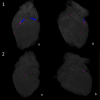Coronary Calcium Characteristics as Predictors of Major Adverse Cardiac Events in Symptomatic Patients: Insights From the CORE 320 Multinational Study
- PMID: 30879377
- PMCID: PMC6475072
- DOI: 10.1161/JAHA.117.007201
Coronary Calcium Characteristics as Predictors of Major Adverse Cardiac Events in Symptomatic Patients: Insights From the CORE 320 Multinational Study
Abstract
Background The predictive value of coronary artery calcium ( CAC ) has been widely studied; however, little is known about specific characteristics of CAC that are most predictive. We aimed to determine the independent associations of Agatston score, CAC volume, CAC area, CAC mass, and CAC density score with major adverse cardiac events in patients with suspected coronary artery disease. Methods and Results A total of 379 symptomatic participants, aged 45 to 85 years, referred for invasive coronary angiography, who underwent coronary calcium scanning and computed tomography angiography as part of the CORE 320 (Combined Noninvasive Coronary Angiography and Myocardial Perfusion Imaging Using 320 Detector Computed Tomography) study, were included. Agatston score, CAC volume, area, mass, and density were computed on noncontrast images. Stenosis measurements were made on contrast-enhanced images. The primary outcome of 2-year major adverse cardiac events (30 revascularizations [>182 days of index catheterization], 5 myocardial infarctions, 1 cardiac death, 9 hospitalizations, and 1 arrhythmia) occurred in 32 patients (8.4%). Associations were estimated using multivariable proportional means models. Median age was 62 (interquartile range, 56-68) years, 34% were women, and 56% were white. In separate models, the Agatston, volume, and density scores were all significantly associated with higher risk of major adverse cardiac events after adjustment for age, sex, race, and statin use; density was the strongest predictor in all CAC models. CAC density did not provide incremental value over Agatston score after adjustment for diameter stenosis, age, sex, and race. Conclusions In symptomatic patients, CAC density was the strongest independent predictor of major adverse cardiac events among CAC scores, but it did not provide incremental value beyond the Agatston score after adjustment for diameter stenosis.
Keywords: calcium density; cardiac computed tomography; coronary artery calcium; coronary artery disease; prognosis.
Figures

Similar articles
-
Incidentally identified coronary artery calcium on non-contrast CT scan of the chest predicts major adverse cardiac events among hospital inpatients.Open Heart. 2021 Oct;8(2):e001695. doi: 10.1136/openhrt-2021-001695. Open Heart. 2021. PMID: 34635575 Free PMC article.
-
Prognostic Value of Coronary Artery Calcium Scoring in Addition to Single-Photon Emission Computed Tomographic Myocardial Perfusion Imaging in Symptomatic Patients.Circ Cardiovasc Imaging. 2016 May;9(5):e003966. doi: 10.1161/CIRCIMAGING.115.003966. Circ Cardiovasc Imaging. 2016. PMID: 27165700
-
Spatially Weighted Coronary Artery Calcium Score and Coronary Heart Disease Events in the Multi-Ethnic Study of Atherosclerosis.Circ Cardiovasc Imaging. 2021 Jan;14(1):e011981. doi: 10.1161/CIRCIMAGING.120.011981. Epub 2021 Jan 19. Circ Cardiovasc Imaging. 2021. PMID: 33461306 Free PMC article.
-
Computed Tomography for Coronary Artery Calcification Scoring: Mammogram for the Heart.Prog Cardiovasc Dis. 2016 Mar-Apr;58(5):529-36. doi: 10.1016/j.pcad.2016.01.007. Epub 2016 Feb 15. Prog Cardiovasc Dis. 2016. PMID: 26892393 Review.
-
Coronary Calcium Risk Score and Cardiovascular Risk.Curr Vasc Pharmacol. 2021;19(3):280-284. doi: 10.2174/1570161118666200403143518. Curr Vasc Pharmacol. 2021. PMID: 32242784 Review.
Cited by
-
Urolithiasis, Independent of Uric Acid, Increased Risk of Coronary Artery and Carotid Atherosclerosis: A Meta-Analysis of Observational Studies.Biomed Res Int. 2020 Feb 20;2020:1026240. doi: 10.1155/2020/1026240. eCollection 2020. Biomed Res Int. 2020. PMID: 32149075 Free PMC article.
-
Long-Term Clinical Outcomes of New-Generation Drug-Eluting Stents in Coronary Artery Disease: A Real-World Observational Study.Acta Cardiol Sin. 2021 Sep;37(5):484-495. doi: 10.6515/ACS.202109_37(5).20210426A. Acta Cardiol Sin. 2021. PMID: 34584381 Free PMC article.
-
The prognostic value of visual and automatic coronary calcium scoring from low-dose computed tomography-[15O]-water positron emission tomography.Eur Heart J Cardiovasc Imaging. 2024 Aug 26;25(9):1186-1196. doi: 10.1093/ehjci/jeae081. Eur Heart J Cardiovasc Imaging. 2024. PMID: 38525588 Free PMC article.
-
Automated cardiovascular risk categorization through AI-driven coronary calcium quantification in cardiac PET acquired attenuation correction CT.J Nucl Cardiol. 2023 Jun;30(3):955-969. doi: 10.1007/s12350-022-03047-9. Epub 2022 Jul 18. J Nucl Cardiol. 2023. PMID: 35851642 Free PMC article.
-
The significance of coronary artery calcium score as a predictor of coronary artery stenosis in individuals referred for CT angiography.J Cardiovasc Thorac Res. 2020;12(3):203-208. doi: 10.34172/jcvtr.2020.34. Epub 2020 Sep 3. J Cardiovasc Thorac Res. 2020. PMID: 33123326 Free PMC article.
References
-
- Agatston AS, Janowitz WR, Hildner FJ, Zusmer NR, Viamonte M Jr, Detrano R. Quantification of coronary artery calcium using ultrafast computed tomography. J Am Coll Cardiol. 1990;15:827–832. - PubMed
-
- Gepner AD, Young R, Delaney JA, Tattersall MC, Blaha MJ, Post WS, Gottesman RF, Kronmal R, Budoff MJ, Burke GL, Folsom AR, Liu K, Kaufman J, Stein JH. Comparison of coronary artery calcium presence, carotid plaque presence, and carotid intima‐media thickness for cardiovascular disease prediction in the Multi‐Ethnic Study of Atherosclerosis. Circ Cardiovasc Imaging. 2015;8:e002262. - PMC - PubMed
-
- Folsom AR, Kronmal RA, Detrano RC, O'Leary DH, Bild DE, Bluemke DA, Budoff MJ, Liu K, Shea S, Szklo M, Tracy RP, Watson KE, Burke GL. Coronary artery calcification compared with carotid intima‐media thickness in the prediction of cardiovascular disease incidence: the Multi‐Ethnic Study of Atherosclerosis (MESA). Arch Intern Med. 2008;168:1333–1339. - PMC - PubMed
-
- McClelland RL, Jorgensen NW, Budoff M, Blaha MJ, Post WS, Kronmal RA, Bild DE, Shea S, Liu K, Watson KE, Folsom AR, Khera A, Ayers C, Mahabadi AA, Lehmann N, Jockel KH, Moebus S, Carr JJ, Erbel R, Burke GL. 10‐Year coronary heart disease risk prediction using coronary artery calcium and traditional risk factors: derivation in the MESA (Multi‐Ethnic Study of Atherosclerosis) with validation in the HNR (Heinz Nixdorf Recall) study and the DHS (Dallas Heart Study). J Am Coll Cardiol. 2015;66:1643–1653. - PMC - PubMed
Publication types
MeSH terms
Substances
LinkOut - more resources
Full Text Sources
Medical

